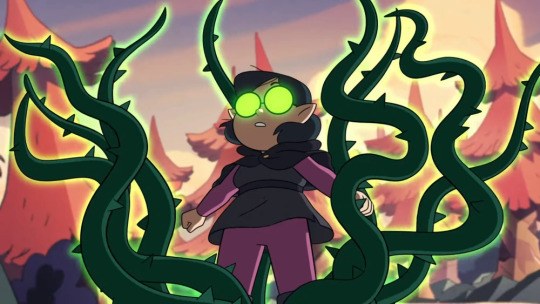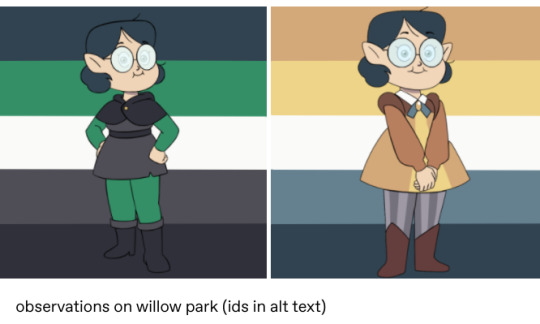#aroace willow manifesto
Text
Blooming Brilliant, an Aroace Willow Park Manifesto

[id: a gif of a heart locket opening. One half of the locket displays a picture of Willow Park from The Owl House, winking and making peace signs with her fingers. Blue and yellow stars surround her. The other half reads "willow park my beloved." /end id.]
Greetings! It’s me, User Aroclawthornes, and instead of working on all the time-sensitive homework I have I sat down and wrote an essay explaining why I think Willow Park OwlHouse could plausibly be read as aroace, and why it would be a thematically enriching interpretation. I’ve never written anything like this before, so it’s oddly formal, a little pretentious, and contains a lot of qualifying language, but I'm confident that it gets my point across. I’m not intending to speak over other interpretations of Willow or assert that it's the only true way to read her, but it's a headcanon I find interesting, and I think there’s a lot of evidence to back it up, between certain elements that Willow’s arc employs to some good old overanalysed symbolism. If you're aspec, I hope this is validating; if you're not, I hope it's interesting; if you don't care, scrolling past it is quick, free, and easy.
Some disclaimers on terminology: I’m speaking from an aroace perspective, and so when I say “aspec coding” I’m generally referring to both orientations as a catch-all - a lot of the coding surrounding Willow could go either way. I’m also going to be talking about commonly accepted “aspec” narratives, but I’m aware of the limitations of this insofar as my experiences are only a single facet of the diverse range of aspec people in this world, so anyone who wants to add or argue anything - respectfully - is encouraged to.
Analysis below the cut!
The Thing About Plants
I’m not going to pretend that an association with plants is historically indicative of aspec coding, because, frankly, there haven’t been enough aspec characters to establish it as a convention, and it’s also a fairly wide-reaching branch of symbolism. However, I am going to propose that lighthearted comparisons between asexual people and plants (however misguided on functions of plant reproduction they are) are fairly common elements of budding ace teenage humour, as are related quips about photosynthesis.

[id: a screenshot of Willow from "I Was A Teenage Abomination", depicting her sitting on the ground while casting a spell over a small, pink flower. /end id.]
I’m also not going to claim that the colour green Belongs To Aromantics, and therefore that All Plants Are Belong To Us, but in tandem with everything else I’m about to cover, the connection between Willow and plants seems like a fairly plausible nudge to a relatively common element of aspec humour.
“Half-a-witch” Willow and the Late Bloomer Experience

[id: a screenshot of Willow with glowing green eyes, from "I Was A Teenage Abomination", depicting her summoning a mess of thorned vines. /end id]
Willow is literally nicknamed “half-a-witch”, in reference to her supposedly incomplete state - this is a sentiment eerily reminiscent of the pressure to find one’s “other half”, which affects aspec - especially aromantic - people particularly profoundly. She’s considered a late bloomer, someone who hasn’t reached the societal milestones of growth at the expected age, and who is derided and considered immature as a result of this perceived failure. However, we quickly discover that Willow is, in fact, an exceptionally competent and powerful witch - taken out of the restricting frame of the Abominations track, she’s able to grow into her own, “complete” person, therefore proving that she was never really lacking in anything in the first place. Like real-life aroace people, she was perceived as limited and immature based on the expectations and judgements of other people, but Willow was never deficient in anything, least of all herself.

[id: a screenshot of Willow and Luz from "I Was A Teenage Abomination". They are holding hands - the former is laughing with her eyes closed, and the latter is grinning, while covered in abomination goop. /end id]
As far as symbolism goes...the track Willow is initially put in literally requires her to conjure up another humanoid entity, with the expectation that she will therefore prove herself to be a whole and mature person. Only with this ability, she’s told, will she be successful and happy as an adult. The shapelessness of her attempts at conjuring an abomination reinforces this connection in my mind - if I may reference this quote from Ducktales 2017‘s (absolutely stellar) A Nightmare On Killmotor Hill, in which the protagonists explore their own subconscious fears via. the dream realm, for a second:
“I think that’s supposed to be my romantic interest, but I’m too threatened by the concept, so it never takes shape.”
A lot of young aroace people find themselves in situations where they attempt to convince themself of their interest in someone in an attempt to be “normal,” or end up lying in response to family members or friends’ questions about crushes. While Willow’s abominations, first and foremost, represent the expectations from her school, classmates, and family to be a successful, “complete” witch with a profitable future, I think that with an aroace interpretation of Willow they could also very easily be read as representing some latent insecurities over a lack of attraction, or pressure to find a significant other.
(I’m not condemning Willow’s dads, by the way - they seem like perfectly lovely fellas, and I’m confident that they were doing what they thought was best for her. They’re certainly very quick to drop everything to assure her future in Escaping Expulsion, so obviously they care about their daughter very much.)
Greens, Blues, and Yellows: Colour-Coding Willow Park
A while back, I made this post comparing Willow’s palette to the aromantic and aroace flags:

[id: a screenshot of a post depicting the aromantic and aromantic asexual flags, colour-picked from images of Willow in her Hexside uniform and casual dress respectively - these are overlaid on top of the flags. The caption reads "observations on willow park". /end id.]
The grey-and-green aromantic flag has long been the accepted mainstream symbol of aromanticism, and, as the above post - and many others - demonstrate, Willow’s palette reflects it near-perfectly. This could easily be a coincidence, owing to the palette of the standard Hexside Plant Track uniform, as well as her hair and eye colours - which are obviously supposed to be reflective of her plant-related abilities. However, given how fond of employing hidden meanings The Owl House has shown itself to be, I don’t think it’s far-fetched to claim that there’s at least a chance that her palette was constructed with the flag in mind.
The latter is...a bit more problematic for me, although it’s fun to joke about. The blue-and-yellow aroace flag was only created in December 2018, relatively late into The Owl House’s initial production, and it’s still relatively obscure, although on the rise in popularity as the accepted aroace flag (I only recently started using it myself), so I don’t know if Willow’s casual wear is enough to verify the presence of any deliberate subtext. I think it’s a fun coincidence, however, and (as was pointed out in this post) it’s cool that these blue and yellow stars surrounding Willow occur in the same frame as Luz’s bisexual decor:

[id: a photograph of Luz, Gus, and Willow, all surrounding a disgruntled-looking Principal Bump. Luz has flowers in the colours of the bisexual flag decorating her hair, while Willow is surrounded by bright blue and yellow stars. /end id.]
also seen above: powerful bi/aspec solidarity
Conclusion:
Do I genuinely believe that Willow is being deliberately written this way? If you’d asked me, say, two months ago, I’d have said probably not - as far as queer representation in kids’ cartoons has come, it has a ways to go, and focusing on transgender characters seems like a more obvious (and equally invaluable) route to go down. I can name maybe five explicitly aspec characters off the top of my head, two of whom have been written as alloromantic and/or sexual in adaptations or continuations of the source material (I have...some grievances with 2005 Doctor Who). But the emergence of Raine, an explicitly nonbinary character on Disney Channel, has given me a little spark of hope, and so, even if it’s never confirmed, it’s comforting to be able to see a character with such strong elements of aspec coding and think to myself, just maybe, that there might be some intent behind it.
I also...really want to see interesting things done with Willow. We’re halfway through Season 2, and despite some promising setup for her arc in the Season 1 finale, she’s sort of been left by the wayside lately in favour of developing the more “plot-relevant” characters, such as Luz, Amity, Eda, and Hunter. Frankly, I think it’s a disservice to her Season 1 development, despite how much I adore all the characters I just listed - beyond any personal motivation, the prospect that Willow could be aroace adds a lot of sorely-sought depth to her, and, as detailed, a lot of this has already been set up in her earlier episodes. I just...I think it’d be neat. Rarely do you get a kids’ show so brazenly queer in its themes as Owl House, and aspec people deserve to be included in that.
Willow would also be great aroace representation because, well - those five or so aspec characters I mentioned being aware of are all white or “raceless” (...also written as white, basically), and so an aspec Asian character would be a really lovely step forward in this area. Additionally, all the characters I referred to are also conventionally skinny, and Willow is not only fat, but written in a way that doesn’t treat this feature as a caricature. People who are more knowledgeable on these topics than I are absolutely free to make additions, as is anyone who feels like I’ve left certain details out.
tl;dr: Willow’s association with plants could be read as a cool nod to aspec humour, her “late bloomer” narrative is eerily reminiscent of some common aspec experiences, her palette speaks for itself, and it’d be really cool if we could diversify the so-far fairly bland sphere of aspec representation.
I’m going to conclude this by linking Rose by The Oh Hellos, because they’re my favourite band, they share The Owl House’s initials, and I also think it’s a good Willow song. Peace out.
youtube
#the owl house#willow park#pspspspsps you will read my 1.5k word aroace willow essay#hooting#meta#willow#aroace willow manifesto#fuck it. this is getting posted
35 notes
·
View notes